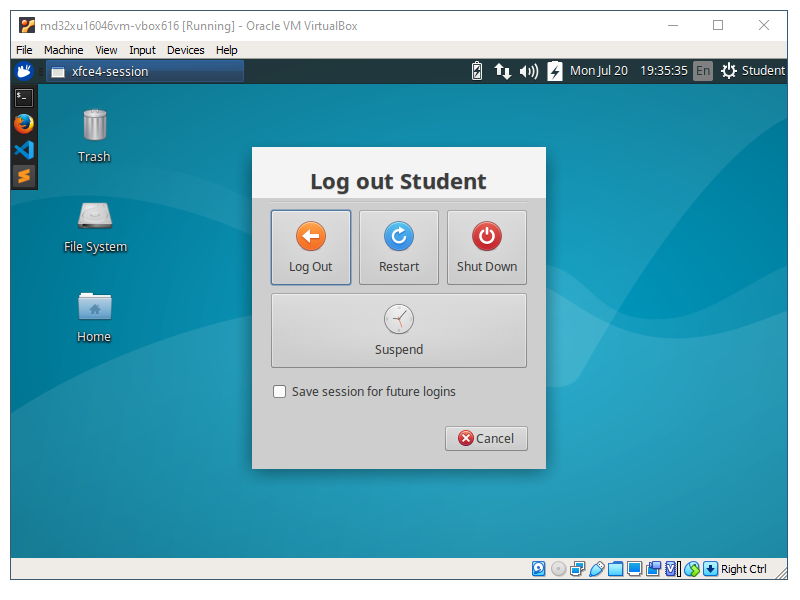

- #SETTING UP A UBUNTU VIRTUALMACHINE ON UBUNTU DESKTOP HOW TO#
- #SETTING UP A UBUNTU VIRTUALMACHINE ON UBUNTU DESKTOP INSTALL#
- #SETTING UP A UBUNTU VIRTUALMACHINE ON UBUNTU DESKTOP ARCHIVE#
- #SETTING UP A UBUNTU VIRTUALMACHINE ON UBUNTU DESKTOP FULL#
- #SETTING UP A UBUNTU VIRTUALMACHINE ON UBUNTU DESKTOP WINDOWS 10#
Ssh -i ~/Downloads/myKey.pem SSH key you created can be used the next time your create a VM in Azure. pem with the path to where the key file was downloaded. Replace the IP address with the one from your VM, and replace the path to the. If you are on a Windows machine, open a PowerShell prompt.Īt your prompt, open an SSH connection to your virtual machine. pem file using chmod 400 ~/Downloads/myKey.pem. If you are on a Mac or Linux machine, open a Bash prompt and set read-only permission on the. On the page for your new VM, select the public IP address and copy it to your clipboard. When the deployment is finished, select Go to resource. pem file was downloaded you will need the path to it in the next step. Your key file will be download as myKey.pem. When the Generate new key pair window opens, select Download private key and create resource. On the Create a virtual machine page, you can see the details about the VM you are about to create. Leave the remaining defaults and then select the Review + create button at the bottom of the page. Under Inbound port rules > Public inbound ports, choose Allow selected ports and then select SSH (22) and HTTP (80) from the drop-down. Under Administrator account, select SSH public key.įor SSH public key source, leave the default of Generate new key pair, and then enter myKey for the Key pair name. To learn more about this new capability, see Create virtual machines in an availability zone. Some users will now see the option to create VMs in multiple zones. Size availability and pricing are dependent on your region and subscription. The default size and pricing is only shown as an example. Under Instance details, enter myVM for the Virtual machine name, and choose Ubuntu 18.04 LTS - Gen2 for your Image. In the Basics tab, under Project details, make sure the correct subscription is selected and then choose to Create new resource group. In the Virtual machines page, select Create and then Virtual machine. If you don't have an Azure subscription, create a free account before you begin.
#SETTING UP A UBUNTU VIRTUALMACHINE ON UBUNTU DESKTOP INSTALL#
To see your VM in action, you also SSH to the VM and install the NGINX web server.
#SETTING UP A UBUNTU VIRTUALMACHINE ON UBUNTU DESKTOP HOW TO#
This quickstart shows you how to use the Azure portal to deploy a Linux virtual machine (VM) running Ubuntu 18.04 LTS. The Azure portal is a browser-based user interface to create Azure resources. Azure virtual machines (VMs) can be created through the Azure portal.
#SETTING UP A UBUNTU VIRTUALMACHINE ON UBUNTU DESKTOP FULL#
In our case, the Ubuntu ISO image will contain everything we need for not only our installation, but also a live version that will allow us to try out Ubuntu before committing to a full install.
#SETTING UP A UBUNTU VIRTUALMACHINE ON UBUNTU DESKTOP ARCHIVE#
We’ll go ahead and use techopedia’s definition: An ISO image is a type of disc image that acts as an archive file that is comprised of all sector data contained in an optical disc, including its file system. We will need to navigate to the Ubuntu downloads page so that we can go ahead and grab the. iso that we can use for our Operating System installation. This will include downloading and installing Oracle VM VirtualBox (or some other Hypervisor software such as VMware), as well as making sure we have an Ubuntu.

Now we will need to make sure that we have the software and files required for our operating system install.
#SETTING UP A UBUNTU VIRTUALMACHINE ON UBUNTU DESKTOP WINDOWS 10#
Great, so this essentially means that we can use our host machine (in my case for this tutorial it will be using the Windows 10 Operating System) and then create a virtual “guest” machine on top of it, which will run our Ubuntu Operating System.īy utilizing virtualization, you can get the best of both worlds and easily interact with numerous Operating Systems, spinning up/winding down VMs with ease. This means that, for example, a virtual MacOS virtual machine can run on a physical PC. Each virtual machine runs its own operating system and functions separately from the other VMs, even when they are all running on the same host. One or more virtual “guest” machines run on a physical “host” machine. First off let’s go ahead and define what exactly a virtual machine is…Īccording to VMware, “A Virtual Machine (VM) is a compute resource that uses software instead of a physical computer to run programs and deploy apps.


 0 kommentar(er)
0 kommentar(er)
